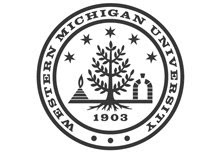Mattawan High School students enrolled in Nancy Garman’s calculus classes were recently challenged to design a goblet using their math skills. The students’ computational responses were then sent to Dr. Mitchel Keil, an IME professor, who created prototype goblets from the students’ work.
Nancy Garman (standing), a 21-year veteran calculus teacher at Mattawan High School, reviews 16 goblet prototypes made by Dr. Mitchel Keil (seated) on a rapid prototyping machine (shown in the foreground). The prototypes are based on equations prepared by Mattawan High School math students
“This was a little end-of-the-year project to design a goblet,” Garman said. “Making the prototypes added a realistic dimension to the math.”
Garman’s 48 advanced math students were organized into 16 groups of three and required to produce the calculations for a goblet that met two criteria: the goblet had to be made with a specific amount of material and the goblet had to be able to hold a specific amount of liquid. She worked with Mattawan’s drafting teacher and CAD teacher on the project.
“The students had to design a goblet with those specifications using not only this year’s calculus, but also a lot of translations, scale changes, and what they had learned in functions last year,” Garman said.
The students used Pro-E, a computer-aided design software program that creates solid models. They also maintained engineering notebooks about the process they used and prepared a final report.
Although the computations were sent to Keil, he credits Jai Thomas, a Ph.D. graduate assistant, with doing the actual work of making the prototypes.
Thomas used the rapid prototyping machine in the Center for Integrated Design at WMU’s College of Engineering and Applied Sciences at Parkview Campus. The process of making the 16 goblets took about seven hours.
According to Keil, the rapid prototyping machine creates prototypes – made from cornstarch – layer by layer using the computer calculations. “The process of getting the student design files to the machine is actually kind of simple,” he said.
Keil was generally impressed with the prototypes. “Several goblets are very close to meeting the criteria,” he said. “Only one seems a little small and one definitely seems very large.”
The prototype goblets were returned to the students who reviewed their computations and reported on any problems. “We pick apart their mathematics to discover what they did wrong,” Garman said.
Garman, a 21-year veteran math teacher, first used prototypes a year ago when her calculus students completed a similar project as part of a National Science Foundation grant study led by WMU engineering professor Dr. Andrew Kline. His grant project was completed last year, but this year’s advanced math students at Mattawan had heard rave reviews from last year’s students and wanted to do a similar project.
“The kids really liked doing this last year,” Garman said. “They gained a lot of understanding from the actual prototypes.”
The Mattawan Foundation was credited for providing grant funds for this year’s project, and Garman said that if funding is available, she plans to do a similar project next year. “This is very valuable for the students,” she said.
---Story and photos courtesy of Kalamazoo Gazette






